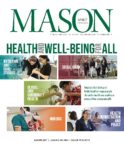When Mason anthropology professor Linda J. Seligmann and her husband adopted a baby girl from China in 2000, the reception they received triggered her professional, as well as personal, curiosity. The experience led to her latest book, Broken Links, Enduring Ties: American Adoption across Race, Class, and Nation (Stanford University Press, 2013), which focuses on families who have adopted children from China and Russia, and families who have adopted African American children transracially.
What made you decide to write the book?
When my husband and I adopted our daughter from China, I began to be aware of a much wider range of reactions to us as a family than I initially thought there would be. The comments reflected curiosity, ignorance, and sometimes pleasure that we had “saved” a child, and now and then a potent dose of racism. Strangers felt free to overstep boundaries of privacy that they might usually have respected.
As an anthropologist, I came to think that there were cultural assumptions that must be driving these comments and behaviors. I began to be interested in understanding better what those assumptions were and, especially, how they affected the lives of adoptive families.
Many people have done research on adoption, but most of that research has been from a psychological, social work, or therapeutic orientation rather than anthropological perspective, and it has heavily relied on survey data and experimental methods.
For your book, you relied on interviews instead.
Yes, over five years, I conducted open-ended interviews and participant observations with adoptive and nonadoptive parents and grandparents, with children and teens, as well as with brokers in the adoption process—attorneys, social workers, and government bureaucrats. The families I spoke with lived in rural, urban, and suburban areas across the United States. Some of the interviews lasted up to six hours at a time because people wanted to talk openly about their experiences.
Was there anything you learned during your research that surprised you?
I was most surprised by the quiet efforts that adoptive parents were making to create open channels with birth relatives. These were not easy undertakings because of divides of class and the values associated with particular class positions and geographical distance in the case of transnational adoptions. Adoptive and birth relatives have created rituals that acknowledge multiple parenthood and ties among them. Some regularly get together. In many cases, the children themselves have encouraged these relationships.
I also found that adoptive families themselves wanted to share their experiences.
While some of the adoptive parents I spoke with had also embraced aspects of the cultural assumption that the normative American family should comprise heterosexual parents and children who looked like the parents and were biologically related to one or both of them, many more of them were fighting against these assumptions. They were trying to take account of their children’s roots; for example, fighting back against classroom assignments that were narrowly defined, such as making family trees. They were also trying to achieve more open channels on a regular basis with birth relatives of their children.
A number of interesting experiments were under way, and even if they were not always successful, they indicated that the shape and practices of American families were changing in significant ways that might, eventually, undermine some of those assumptions.
Another thing that surprised me was that I knew many adoptive parents with children from Russia had taken that path because they very much embraced traditional assumptions about what an American family was and believed that adoption was “second best.” They wanted desperately to pass as a biological family. I found evidence of this, but what I found was that adoptive parents also wanted to protect the privacy of their family, especially their children, from the kinds of invasive questions I had experienced.
Assimilation has always been a big issue, and I imagine that it plays a role in outsiders’ reactions to these families.
In an earlier era, Korean American adoptees had been expected to simply assimilate and become “white,” rejecting their roots and culture. Many transnational adoptive families have taken to heart the suffering these adoptees experienced and have tried to respect their children’s cultural heritage and roots by taking their children back to China and introducing them to Chinese food, language, and dance, for example.
Yet the children themselves, especially as they get older, have rejected many of these efforts because they themselves, like so many immigrants, are not Chinese, but rather Chinese American. The children are trying to bring together these multiple strands of their identities—they make circuit journeys to their country of origin; they have fictive kin ties with “crib mates” from their social welfare institutes or orphanages; they defy school assignments like the family tree and create bushes with multiple branches and novel kinship terms; they hold annual gatherings where they recognize their losses yet also celebrate who they are that allows them to defy being slotted into a single category; and they share their stories with each other, creating emergent communities.
What do you think the future holds for international and transracial adoptions?
I think that the more open discussions and exchanges about adoption are leading to serious reflections on how geopolitical inequalities structure adoption practices, both within the United States and between the United States and other countries. There is a growing awareness of the need to define and defend children’s rights in a broad fashion to prevent child trafficking, the horrors of re-homing, and the ease with which those with greater economic and political power are able to proceed with adoptions that may not be in the best interest of the child. At the same time, there’s a long way to go in defining exactly what we mean by children’s rights.
I also think that we need much more longitudinal research on the experiences, sentiments, and the cultural practices of transracial adoptees, as they move from childhood to adulthood and form their own families.


No Comments Yet »
Leave a comment